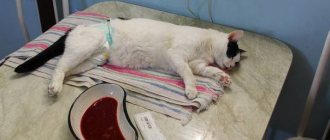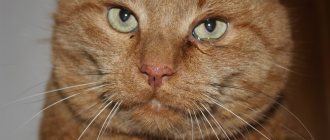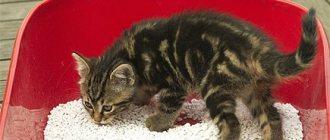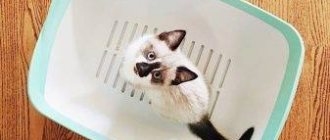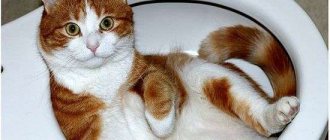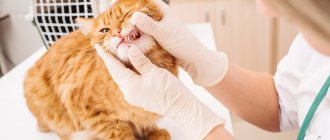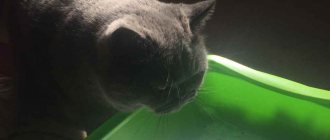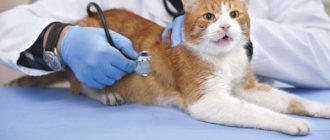Symptoms of diarrhea
Diarrhea is characterized by general symptoms:
- loose stools;
- frequent bowel movements;
- flatulence;
- blood, mucus and feces.
If diarrhea signals an illness, secondary symptoms may appear:
- decreased or increased appetite;
- weight loss;
- vomit;
- temperature increase;
- decreased pet activity;
- drowsiness.
Secondary symptoms should be addressed as early as possible. To diagnose the disease in time and begin treatment.
Duration
Loose stools in cats can last for varying durations. Sometimes the sudden onset of diarrhea also ends suddenly. During this time, the animal did not change its behavior or appetite. A one-time bowel movement is not a reason to be upset. The manifestation of diarrhea and its continuation for a certain time divided it into certain groups.
- acute – the duration of diarrhea is more than two days;
- chronic – more than 7 days;
- intermittent – up to 30 days.
The first group does not pose a threat to health and is limited to hunger and a decrease in water during the first two days. Apply a diet. Within two days the cat’s body will recover.
The chronic group obliges you to contact a veterinary clinic. Since the cause of the disease should be identified and treatment prescribed.
An intermittent group entails not only illness, but also dehydration, so the animal must be examined.
Why can a cat poop with blood in it?
An owner who notices blood there when cleaning the tray should analyze whether other unpleasant signs are present. So, it is worth paying attention to the consistency and volume of feces, the frequency with which the pet visits the litter box, and observe the cat’s behavior during bowel movements. The veterinarian will first ask for this information before examining a sick animal.
Table 1. Most Common Factors Causing Blood in Cat Stool
| Cause | Manifestation |
| Improper feeding, poor or unbalanced diet, feeding cheap dry or wet (patches, canned) food, lack of fluid in the cat’s body, lack of constant access to water | If an animal receives low-quality dry food, eats poorly and sparingly (large amounts of fiber, cereal, bread products), this can cause chronic constipation and inflammation of the rectum. The cat's constant lack of clean drinking water leads to the same problem. Feeding a cat bones, especially tubular ones, is dangerous (including if the animal caught the bird while hunting). In this situation, the bones can crumble inside, and sharp fragments literally cut the gastrointestinal tract along its entire length. In general, with such a diet, dry feces are formed, which injure the mucous membrane. |
| Ingestion of a foreign object | If a cat accidentally swallows a foreign object that has sharp edges or an irregular shape (a chip, a toothpick, a needle, a piece of plastic, etc.), then when it comes out, it also injures the mucous membranes. Both internal organs and the rectum and anal tissue can be damaged. |
| Accumulation of hairballs in the stomach | The problem affects cats with long hair. If the fur is not expelled through vomiting, then the lumps begin to come out naturally, clogging the rectum, injuring it, causing microcracks. Also, the cat may push excessively in an attempt to get rid of dense feces, which leads to damage. |
| Poisoning from rodent chemicals | The poisons used to poison mice and rats contain anticoagulants that tend to cause heavy stomach bleeding or bleeding in the rectum. A cat can be poisoned either directly - by eating or smelling poison, or by hunting, by catching a poisoned rodent. |
| Lack of vitamins, problems with blood clotting | Bloody discharge can cause chronic vitamin K deficiency in the animal's body, as well as blood clotting disorders. In the latter situation, even a small internal injury can result in severe bleeding. |
| Helminthiases and the presence of other protozoa | A cat infected with parasites may show up as blood in the stool. The fact is that many helminths attach to the walls of the animal’s internal organs, including the stomach, intestines and rectum. With sharp hooks and suction cups, protozoa injure the mucous membrane, causing bleeding, and also thin the tissue and provoke capillary permeability, which has the same result - blood in the stool. |
| Allergic reactions | Most often, bloody discharge in cat feces is caused by a food allergy. |
| Chronic colitis | In this situation, in addition to blood, mucus will also be present in the stool. |
| Benign formations, polyps in the intestines (large section) | If an animal suffers from non-cancerous neoplasms, then the cause of bleeding lies in the fact that feces, passing through the large intestine, injure the tumors and tissues of these formations, which is accompanied by the appearance of drops of blood in the tray. |
| Malignant formations | Cancerous tumors in any part of the gastrointestinal tract can give similar symptoms. Note that this cause of blood in a cat’s stool is quite rare, since blood discharge appears already in the last stages, and before this, the owners manage to notice from other signs that the pet is sick. |
| Problems with the liver, stomach, pancreas | Ulcerative injuries, acute gastritis, pancreatitis, liver dystrophy - these ailments can manifest themselves as blood in the feces. |
| Infections of viral or bacterial etiology | An infected animal not only poops with blood, but also suffers from vomiting and diarrhea, fever, intoxication, and dehydration. The condition is acute. |
| Dysbacteriosis | Diarrhea, bloating, and blood in the feces can be the result of a disturbance in the animal’s microflora due to antibiotic therapy, a serious illness, surgery, or an incorrectly chosen diet. |
Blood in a cat's stool is most often associated with improper functioning of the gastrointestinal tract.
Important point! In a situation where an animal poops blood, it is unacceptable to make a diagnosis yourself. Blood in the stool is a nonspecific symptom that can mean a dozen different ailments. Only a qualified pet doctor can make decisions regarding treatment for a cat.
Video - Blood in animal feces
Causes
Diarrhea is caused by the following diseases:
- parasites – diarrhea is characterized by white diarrhea;
- cancer – blood in stool;
- kidney and liver disease - white or orange stool, possibly clogged ducts in the pancreas;
- high blood sugar;
- intestinal obstruction – blood, mucus in the stool;
- fungal bacteria;
- pancreatitis is accompanied by chronic diarrhea with the presence of secondary symptoms;
- viral infections - the color may vary depending on the severity, but secondary symptoms are always present;
- bacterial infections – blood and mucus are present.
Cat diarrhea can be caused by external factors:
- stale food;
- replacing food with another company;
- reaction to unusual food;
- wrong diet;
- food intolerance;
- too large dose of feed;
- drug poisoning.
Liquid stool due to external factors is one-time, with water or green in color, and can disappear on its own without treatment. It is enough not to feed for 2 days, limit water.
Warning signs and symptoms
When cleaning up the pet's potty, the owner may discover that there are several drops of blood on the feces, or that the entire mass of feces is colored reddish. Let us note right away that this is not normal, and such a signal indicates that the animal needs increased observation and attention from humans.
If blood was detected in the stool of a furry pet once, the symptom did not recur again, and the general condition of the animal is assessed as good (that is, the pet is cheerful, cheerful, eats, actively responds to affection), there is no need to worry. Most likely, there was a one-time injury to the animal’s rectum (for example, the mucous membrane could have been scratched by a sharp piece of undigested food or a small foreign object that came out naturally).
The general condition of the cat is an indicator of health
If blood appears in the stool again and again, you need to find out the reason for its appearance immediately. In a situation where bloody spots in the animal’s feces are accompanied by such manifestations as lethargy or lethargy of the pet, diarrhea or constipation, refusal to eat, increased or decreased body temperature (the norm for an adult cat is within 38-39 degrees), you need to take the pet to the clinic immediately.
The severity of the problem at the initial stage can be assessed by the owner himself. You need to make an appointment at the veterinary clinic on the same day if your cat has the following problems:
- The bleeding is profuse (not streaks or droplets, but whole puddles).
- Blood flows from the anus even when not having a bowel movement.
- The animal screams on the potty, showing pain.
- The cat is vomiting.
If the cat wants to go to the toilet, but cannot, the problem requires the intervention of a doctor.
It is not at all necessary (and even impossible) that all of these symptoms will appear simultaneously. The manifestation of at least one of them, together with the blood that appears in the tray, is enough to show the pet to a qualified veterinarian. It is worth remembering that bleeding from the anus can cause the death of a cat quite quickly!
Important! If the listed symptoms are observed not in an adult animal, but in a kitten, you need to act very quickly. Due to the kitten’s fragile body and shaky immunity, the signs mentioned above can become fatal.
Apathy and refusal to eat are the first alarming symptoms
Types of diarrhea in cats
Based on the color and consistency of feces, experts often determine the cause of a cat’s disease.
A healthy pet will have feces that are brown in shape and have a slightly soft consistency. The frequency of bowel movements is usually 1-2 times a day. If very soft or mushy bowel movements are observed, their frequency has increased to several times a day - this is a signal that something wrong is happening to the cat. Doctors distinguish several types of diarrhea.
Diarrhea with water
The appearance of water in the stool during a single bowel movement does not threaten the health of the cat. The pet behaves normally, does not lose its appetite, the color and smell of the stool is normal. The reasons for this manifestation may be the following:
- spoiled food;
- feed replacement;
- motion sickness as a result of a long trip;
- stressful situation (new pet, going to the doctor);
- reaction to unusual foods (raisins, chocolate, nuts, milk);
- incorrectly formulated diet.
Prolonged diarrhea with water indicates the development of the disease. In this case, you should not self-medicate and you must take the cat to the veterinary clinic for examination.
Important! A timely visit to the doctor will prevent the disease at an early stage, which will reduce the risk of complications.
With blood
The appearance of blood in the stool is an alarming signal. The symptom indicates that there is severe inflammation in the intestines. In this situation, the mucous membrane peels off, which leads to bleeding. In addition to primary signs, the animal has secondary symptoms: vomiting, fever. Prolonged diarrhea causes anemia. As a result, weakness appears and the body becomes dehydrated. Reasons may include:
- Worms.
- Poor quality food, complications after infectious diseases, medications that cause hemorrhagic gastroenteritis.
- Bacterial infection – Q fever, nocardiosis, tick-borne borreliosis.
- Toxoplasmosis is a dangerous parasitic disease that can lead to the death of a cat.
- Viral infection – calicivirus, herpervirus, metal panleukopenia.
- Intestinal obstruction - a foreign body in the gastrointestinal tract (gastrointestinal tract) - buttons, threads, needles, Christmas tree tinsel. Tumor of the digestive organs, volvulus, hernia.
- Disease of the large intestine - colitis.
If this type of diarrhea is detected, you should not take the problem lightly; any delay in visiting a doctor could result in the death of the cat.
Green diarrhea
The reason for the green color of a cat's feces indicates that the pet ate low-quality food the day before. As a result, putrefactive processes develop in the body. In turn, they release toxic substances that cause irreparable harm to the animal.
Diarrhea should not be allowed to last more than 2 days, but treatment should be started as quickly as possible. Since the functioning of the pancreas is disrupted, the cat loses weight, although her appetite is brutal. During this illness, you will need to put in IVs, and a trip to the veterinarian is necessary.
White
Bilirubin contained in bile turns cat stool brown. This is the case when their supply is in normal quantities. The slightest deviation from the norm will lead to different shades. When the intestines do not receive enough bilirubin, the color of the urine becomes white.
The cause may be parasites that have clogged the bile ducts. The pet suffers not only from the primary symptoms, but also experiences severe discomfort.
Yellow
During normal stomach function, yellow bilirubin turns brown. If digestion occurs very quickly, bilirubin does not have time to turn brown, but comes out in its natural color. During diarrhea, processes occur at an accelerated rate and the yellow color can be considered normal unless it becomes brighter in color, signaling the disease.
Orange
In this case, bilirubin, during processing in the stomach, turns orange. This indicates a supersaturation of elements in the blood. The cause of the color change is liver disease - jaundice. In addition to the primary symptoms, the cat has secondary signs: yellow eyes and gums, lethargy, weight loss, refusal to feed.
Black
Iron-containing vitamins can turn stool black. If the cat feels well, then there is no concern. When symptoms appear: vomiting, lethargy, fever, the animal suffers from bleeding of internal organs. Therefore, this is a signal of a serious illness.
Diarrhea with mucus
The presence of mucus in stool is observed for many reasons:
- viral infection;
- bacterial infection;
- anthelmintic drugs;
- the presence of parasites (giardia, worms, isospores).
Secondary symptoms may include weight loss, loss of appetite, and general malaise.
Diarrhea + vomiting
The cat's digestive system cannot cope with food. The result is diarrhea and vomiting. The following diseases can also cause vomiting:
- pancreatitis or inflammation of the pancreas;
- tumor;
- thyroid disease;
- obstruction of the esophagus or intestines;
- kidney disease.
In most cases, cats suffer due to the fault of the owner when food incompatible with the pet’s digestive system gets into their food.
Diarrhea after vaccination
A healthy cat does not respond to vaccination. But there are cases when a cat develops diarrhea. The vaccine caused an exacerbation of the sluggish disease. In this case, you need to seek help from a veterinarian. A correctly placed injection reduces the risk of complications; read our article on how to carry out this procedure yourself with fewer risks.
Diagnosis of bloody diarrhea
Blood in the stool is a reason to seek help from a veterinarian, especially if:
- the pet experiences severe abdominal discomfort, screams, and does not get up;
- the bloody stool turned black - this is a sure sign of internal bleeding;
- diarrhea with blood accompanied by vomiting;
- bloody diarrhea in a kitten;
- the animal has all signs of dehydration, which can be recognized by increased body temperature, dryness of the oral mucosa, and convulsions.
Treatment
Treatment of diarrhea in a veterinary clinic
When a cat is admitted to a veterinary clinic, the doctor takes a medical history. To do this, the owner will have to answer a number of questions:
- when you notice your cat has diarrhea;
- what type of diarrhea (with mucus, orange, black, etc.);
- what quality of diarrhea (processed food or not);
- presence of parasites (live or dead);
- is there a smell?
- volume, as usual, or less (more);
- pet behavior (activity, lethargy, drowsiness);
- secondary symptoms (fever, vomiting).
Important! Monitor all changes in your pet not only in behavior, but also in the quality, smell, and color of discharge. This will make it easier for the doctor to diagnose.
Next, the doctor conducts a physical examination. Based on the medical history and external examination of the animal, the veterinarian determines:
- form of diarrhea (acute or chronic);
- location of the lesion (small or large intestine);
- the pet’s condition (mild or severe).
Based on the findings, the animal is given first aid and treatment. If your cat's diarrhea is mild and does not last long, your doctor may prescribe symptomatic treatment.
In more complex cases, the veterinarian will need additional tests. It can be:
- urine and blood tests (a general blood test makes it possible to determine hidden bleeding, inflammation, the degree of dehydration; a biochemical blood test determines the functioning of internal organs);
- stool analysis is collected up to three times to identify parasites and bacterial contamination;
- Ultrasound or x-ray of the gastrointestinal tract;
- Endoscopy using a camera to detect tumors, polyps, and inflammatory processes.
Treating diarrhea at home
Diarrhea caused by poor diet is treated symptomatically. The animal is prescribed a starvation diet for 2 days. Drinking is reduced if the disease is accompanied by vomiting; if not, the pet should drink as much fluid as possible to avoid dehydration.
Loss of fluid is replenished with salted chamomile decoction and still mineral water. To do this, force your pet to drink from a pipette or syringe every hour, since he will most likely refuse to drink.
On the third day, you need to start feeding the cat in small portions, gradually increasing them. The body responds well to oatmeal and rice decoctions. After treatment, stick to a diet and avoid feeding foods that are prohibited for your cat.
If the cause is more serious, for example, diarrhea with blood and mucus, it is highly undesirable to treat the cat at home. Incorrect treatment methods can worsen the disease. Diarrhea is accompanied by dehydration, to compensate for reserves, the veterinarian will prescribe IVs with saline solution, antibacterial drugs to relieve pain and spasms, and hemostatic medications.
Oncology
Malignant neoplasms very often lead to the death of the animal. The cat’s immunity gradually decreases, and its organs begin to function incorrectly. To date, veterinarians have not identified the exact causes of malignant neoplasms. But there are factors that increase the likelihood of developing cancer in a cat:
- inhalation of cigarette smoke;
- hormonal imbalances;
- decreased immunity;
- unbalanced diet;
- constant stress;
- heredity.
Why does a cat go to the toilet with blood? Oncological disease in the later stages interferes with the functioning of all organs. Cancer is most often detected in animals over 5 years of age. Oncology can only be treated in a clinic; it is impossible to help a cat at home. The animal undergoes surgery to remove the tumor, and then is prescribed chemotherapy. In some cases, the cat is irradiated.
What medicine should you give your cat?
After all examinations, treatment is prescribed for each animal individually. These may include the following medications.
Levomycetin
Taken in the fight against gram-positive and gram-negative microorganisms. While taking the drug, you should follow the instructions. Since if violated, side effects are possible: dermatitis, skin rash, kidney damage.
Phthalazole
The drug helps in the treatment of salmonellosis, dysentery, and colitis. Has an antimicrobial agent. The tablet is divided into 4 parts, one of them is dissolved in water and sprayed into the pet’s mouth using a syringe. The medicine should not be used on animals with liver or kidney disease, or on pregnant cats.
Important! Tablets are used only as prescribed by a doctor.
Furazolidone
Broad-spectrum antimicrobial drug. Prescribed by a doctor. Use three times a day with meals.
Smecta and activated carbon
Enterosorbents free the body from toxins. It is used if diarrhea is short-lived.
Depending on the severity of the disease, the therapist may prescribe:
- intravenous injections for dehydration in the following composition: ascorbic acid, glucose, sodium chloride;
- antihelminthic drugs;
- a general strengthening complex for the body.
What to do if a kitten or pregnant cat has blood in the stool
Waiting until blood appears in the stool of a pregnant cat or very young kittens is unacceptable. The animal must be examined by a veterinarian, preferably at home. Blood in the stool of kittens most often indicates an infectious disease, as well as errors in the diet during weaning or food intolerance. Blood in a pregnant cat's stool may be bloody discharge from the uterus.
Prescription of medications is carried out only by a veterinarian, since, for example, the use of anthelmintics, which are acceptable during pregnancy in cats, may be unacceptable in this particular individual if it has other contraindications. In severe cases, the prospect of continuing pregnancy, as well as breastfeeding, is assessed only by a veterinarian, since these conditions greatly limit therapeutic options. Therefore, it is important to vaccinate and worm your cat before pregnancy.
Nutrition
The best treatment for diarrhea is fasting. But it should last no more than 2 days. In the next 24 hours, you need to force-feed 4 times a day, in small portions, usually the total dose is halved.
Water should always be poured. The dishes must be disinfected.
From the diet you need to exclude all dairy, carbohydrates, starch contained in foods, smoked foods, and sweets. Limit fatty foods. Use easily digestible foods: rice, boiled yolk, boiled chicken.
Cats accustomed to dry food will have to give it up for a while. To do this, purchase special canned food in the store that is gentle on the gastrointestinal tract. You can switch to your usual diet after complete recovery.
Prevention
Diarrhea is better prevented than treated. During illness, the cat suffers physically and psychologically. Fulfill certain requirements:
- Keep the cat's house or area clean. To do this, change and wash the bedding once a week.
- After eating, throw in any leftover food and rinse the dishes. Sour food will cause poisoning of the body.
- Buy dry food of the highest class, from a well-known manufacturer. If you want to change its brand, do it gradually. So that the animal’s body can adapt to new food.
- Disinfect litter trays.
- As soon as a kitten appears in the house, you need to consult a veterinarian about timely vaccinations. This will prevent many diseases.
- Make it a rule to periodically do preventive treatments against worms (2 times a year).
- Do not keep chemicals that can cause poisoning open or accessible to cats.
- Avoid contact of your pet with animals that have viral infections. Some of them cannot be treated. Before visiting the exhibition, take additional prophylaxis with fosprenyl (against viral diseases).
What causes diarrhea
Frequent and loose stools can be caused by many factors: from changes in diet to serious internal pathologies. Here are some of them.
Causes of diarrhea
Milk often causes diarrhea in cats.
- Change of diet . Milk often causes intestinal upset. This is due to congenital or age-related lack of lactase, an enzyme that breaks down milk sugar.
- Increased eating of grass (especially after a long break, for example, the summer season has begun and the cat is taken to the country).
- Food allergy or hypersensitivity to any food. It often happens that the waste products of some helminths (for example, roundworms) can also cause allergic reactions.
- Parasites (tapeworms and roundworms).
Diagram of parasites reaching a cat
- Viruses (for example, immunodeficiency virus or feline leukemia virus).
- Bacteria (Campillobacter, Salmonella).
- Medicines that have diarrhea as a side effect.
- Poisoning by poisons (accidentally ate any household chemicals).
- Hyperthyroidism (increased levels of thyroid hormones provoke increased contractility of the intestinal wall).
In veterinary medicine, there is a general term for disorders accompanied by diarrhea - inflammatory bowel disease (abbreviated as “ IBD ”). This syndrome is becoming increasingly common in domestic cats.
Cats with IBD symptoms
Teenage cat. The risk of getting into a group is unlikely, but it exists.
- Middle aged (approximately 5–7 years old);
- They defecate frequently, the stool is liquid in consistency;
- Lose body weight, even to the point of exhaustion;
- They have chronic vomiting and diarrhea.

